Catocala whitneyi
Catocala whitneyi
kah-TOCK-uh-lahMWHIT-nee-eye
Dodge, 1874
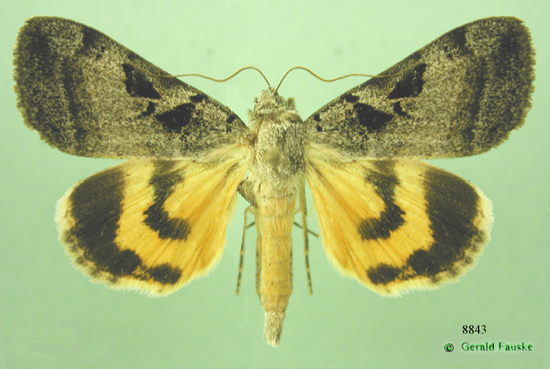
Catocala whitneyi North Dakota, courtesy of Gerald Fauske.
This site has been created by
Bill Oehlke
Comments, suggestions and/or additional information are welcomed by Bill.
| TAXONOMY:
Superfamily: Noctuoidea, Latreille, 1809
Family: Erebidae, Leach, 1815
Subfamily: Erebinae, Leach, 1815
Tribe: Catocalinae, Boisduval, 1828
Genus: Catocala, Schrank, 1802
|
DISTRIBUTION: Catocala whitneyi, Whitney's Underwing
(wingspan: 43-50mm) flies from the Plains states:
North Dakota,
Nebraska and
Kansas
eastward through
Wisconsin to
Ohio unconfirmed and
Tennessee unconfirmed.
It may be found as far west as
Minnesota (confirmed by Tom Middagh)
to Utah. In Canada, specimens
have been taken in Manitoba.
Catocala whitneyi is similar to
abbreviatella Grote, and nuptialis Walker, but
generally flies later in the season where the species overlap.
The two black wedges/triangles on the forewing, one over the reniform
spot and the other just outside the antemedial line, distinguish
whitneyi.
Catocala whitneyi pair, Worthington, Minnesota,
July 7, 1994, courtesy of Tom Middaugh.
| 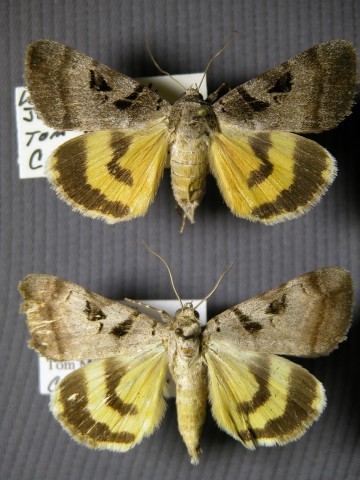
|
FLIGHT TIMES AND PREFERRED FOOD PLANTS:
Catocala whitneyi flies as a single generation with moths on the wing from July into August.
The Catocala whitneyi caterpillar feeds on Leadplant.
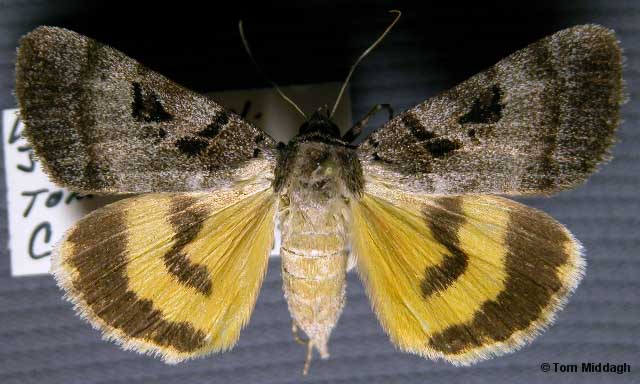
Catocala whitneyi female, Worthington, Nobles County, Minnesota, courtesy of Tom Middagh.
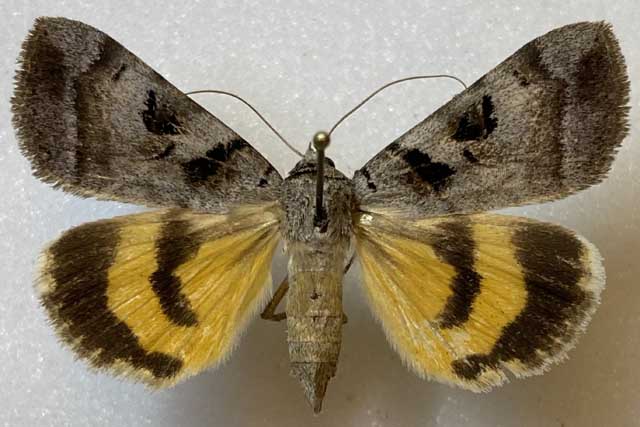
Catocala whitneyi, Gavin's Point, Cedar County, Nebraska,
Jully 12, 2022, courtesy of Scott Wehrly.
ECLOSION:
Adults eclose from pupae formed under leaf litter.
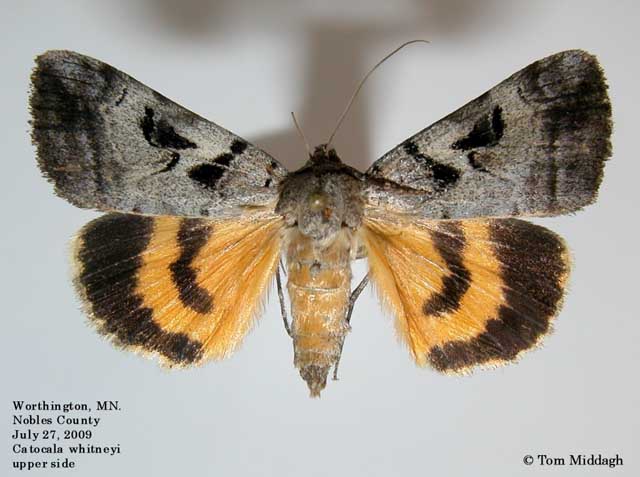
Catocala whitneyi, Worthington, Nobles County, Minnesota,
43mm, July 27, 2009, courtesy of Tom Middagh.
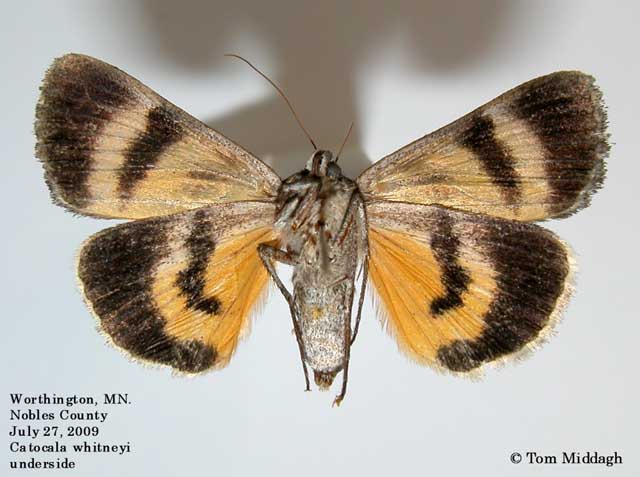
Catocala whitneyi (verso), Worthington, Nobles County, Minnesota,
43mm, July 27, 2009, courtesy of Tom Middagh.
SCENTING AND MATING:
Catocala whitneyi females
emit an airbourne pheromone and males use their antennae to track the
scent plume.
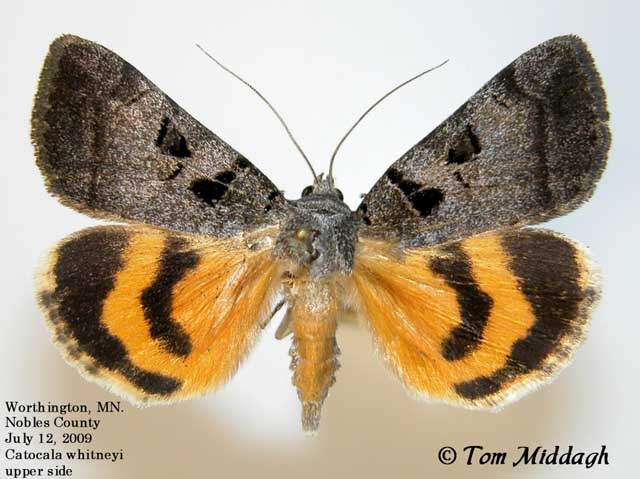
Catocala whitneyi, Worthington, Nobles County, Minnesota,
43mm, July 12, 2009, courtesy of Tom Middagh.
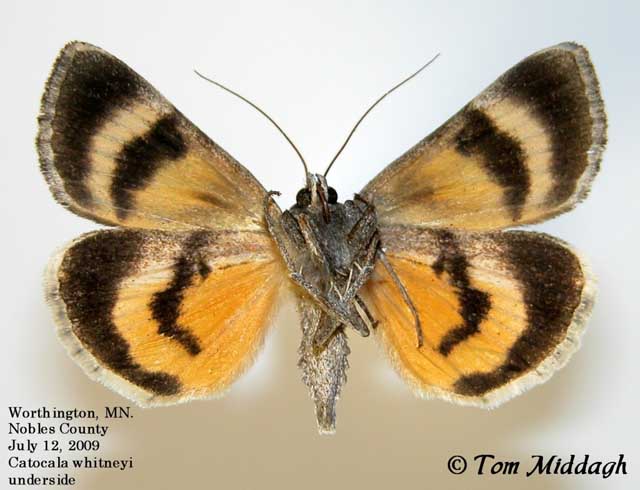
Catocala whitneyi (verso), Worthington, Nobles County, Minnesota,
43mm, July 12, 2009, courtesy of Tom Middagh.
EGGS, CATERPILLARS, COCOONS, AND PUPAE: Eggs are deposited on tree bark in the fall and hatch the following spring.
"Larvae are pale whitish brown with hues of olive, orange and yellow depending on instar and are marked with longitudinal, semi-irregular
grayish-brown stripes and spots (Borth and Barina 1991). The spiracles (breathing pores along each side of the abdomen) are reddish and lack a yellow band
below them.
"Larvae rest near the base of their host leadplant during the day; at night they climb up to the branch tips to feed (Borth and Barina 1991). They are best sought
from late May to early June. After this period, larvae form a shelter of silked-together leaves and enter a quiescent prepupal
state that lasts for approximately five days. The pupal stage lasts for approximately 2-3 weeks. Adults appear to eclose (emerge from the pupa) only at night."
(MN Department of Natural Resources)
Larval Food Plants
Listed below are primary food plant(s) and alternate food plants.
It is hoped that this alphabetical listing followed by the common
name of the foodplant will prove useful. The list is not exhaustive,
although some species seem very host specific.
Experimenting with closely related foodplants is worthwhile.
Amorpha spp.......
|
Leadplant
|
Use your browser "Back button to return to the previous page.
Goto Main Catocala Index
This page is brought to you by Bill Oehlke and the
WLSS. Pages are on space rented from Bizland. If you would like to become a "Patron of the Sphingidae/Catocala Sites",
contact Bill.
Please send sightings/images to Bill. I will do my best to respond to requests for identification help.
Enjoy one of nature's wonderments: Live Saturniidae (Giant Silkmoth) cocoons.

|

To show appreciation for this site, click on the flashing
butterfly to the left, a link to many worldwide insect sites. |
|









